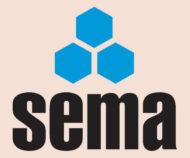Our first question this month asks about Overhang on pallets and the second is enquiring about Self-Fabrication of Pallet & Cantilever Racking.
 Overhang on Pallets
Overhang on Pallets
Q. I understand that the recommended overhang for pallets on racking is a maximum of 50mm on either side of the beam. I have two questions regarding this. Where the overhang exceeds this amount slightly without any other option, what additional controls or structures can be put in place to reduce any risk? for example, if it is back-to-back racking. Could an extension be fitted in the middle?
Secondly, if the pallet has no overhang and is sitting on timber decking and not the beam. is this permissible and if so, what is the average SWL of timber decking?
A. The clearances for normal beamed pallet racking are given in the SEMA Code of Practice for the use of static pallet racking and this gives a normal overhang of 50mm to the front and rear beams. It is important that the pallets are positioned symmetrically in the depth of the rack so that the front and rear beams (and uprights) are loaded equally. If you intend to systematically place the pallets so that they are not symmetrical then the beams (and uprights) must be designed accordingly.
You should also note that, with the pallets in the intended position there should be a clearance of (at least) 100mm back-to-back between the pallets (or load). If the configuration of your racking does not permit this then it does not comply with the SEMA recommendations.
Of course, this value of 50mm overhang is a nominal dimension and small variances are to be expected.
If you have timber decking then the decking needs to be designed to suit the positioning of the pallets i.e. if the pallets are to be placed “inboard” of the beams then the decking must be designed accordingly. The SWL of timber decking varies widely and it is not possible to give an “average” value – you should refer to your supplier for this information.
Self-Fabrication of Pallet & Cantilever Racking
Q. What are the SEMA guidelines for self-fabricated pallet racking and cantilever?
A. SEMA publishes codes of practice for the design of adjustable pallet racking and for Cantilever racking.
The adjustable pallet racking code is written on the assumption that the racking has some sort of “hook-in” type beam end connector and that the uprights are made from thin-gauge cold-formed steel although, with some adaptation, the recommendations could be used for a bolted or welded construction. In the case of a bolted or welded construction, a more appropriate code might be EN1993-1-1 or EN1993-1-3. In the case of the cantilever code it is envisaged that the rack is made from hot-rolled steelwork or some sort of cold-formed steelwork although, again, EN1993-1-1 or EN1993-1-3 could also be applied.
From your question it seems that a company has designed and manufactured some racking. If this is the case then that company has assumed the roles of the Designer, Manufacturer and Installer. This means that the company must ensure that the equipment satisfies the requirements of the Provision and Use of Work Equipment Regulations. Amongst a host of other things, that company is now responsible for determining the safe load carrying capacity of the racking, how it should be installed, communicating any instructions on correct use to the workforce, giving information about maintenance procedures and providing any other limitations on the use of the rack and any damage assessment criteria that might be relevant. These are onerous obligations and the reason that racking is normally sourced from specialist suppliers experienced in this work.
A SEMA Approved Rack Inspector (SARI) could carry out an annual assessment using the normal criteria that would be used with respect to commercially available racking plus any other criteria specified by the designer of the equipment.
One of the things that the SARI will check is the Load Notice. Therefore, the Safe Working Load (SWL) limits of the rack design will need to be available to the SARI.
SEMA Rack Safety Awareness Inspection Courses
SEMA runs a one-day safety course on Rack Safety Awareness and Inspection. These courses are aimed at end users, giving an in-depth look at the need for inspections, how to conduct an assessment and what actions to take when this is completed. These courses are held at the SEMA headquarters in Burntwood, Staffordshire, but arrangements can be made to hold them at the delegates’ premises.
SEMA Approved Rack Inspectors Qualification
This qualification is aimed at professionals who conduct rack surveys as an integral and significant part of their duties. It involves delegates in undertaking an in-depth SEMA Course, together with an examination and practical assessment. CPD will be an important part of the qualification, demonstrating to end users that SEMA Approved Inspectors maintain a high professional standard.
SEMA Publications
SEMA has 26 publications in stock – Codes of Practice, ‘Guides’ and European documents – all of which are available to purchase online.
SEMA




Comments are closed.